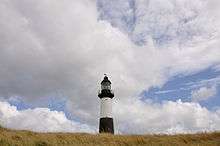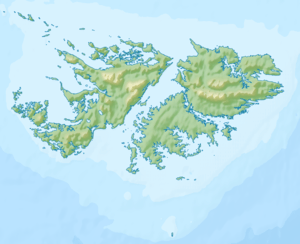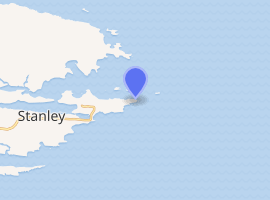Cape Pembroke
Cape Pembroke (Spanish: Cabo San Felipe)[1] is the easternmost point of the Falkland Islands, and is on East Falkland. There is an automated lighthouse here.
Lighthouse
 Cape Pembroke Lighthouse | |
 Cape Pembroke Lighthouse Falkland Islands | |

| |
| Location | Cape Pembroke Falkland Islands |
|---|---|
| Coordinates | 51.681834°S 57.720400°W |
| Year first constructed | 1855 (first) |
| Year first lit | 1987 (current) |
| Deactivated | 1982 (first) |
| Construction | cast iron tower |
| Tower shape | cylindrical tower with balcony and lantern |
| Markings / pattern | black tower with a horizontal white band, black lantern |
| Tower height | 18 metres (59 ft) (first) |
| Focal height | 30 metres (98 ft) (current) |
| Original lens | 3rd order Fresnel lens |
| Range | 10 nautical miles (19 km; 12 mi) |
| Characteristic | Fl (3) W 20s. |
| Admiralty number | G1352 |
| NGA number | 20336 |
| ARLHS number | FAL-001 |
| Managing agent | Falkland Islands Museum and National Trust[2] |
An automated 18 metres (59 ft) lighthouse on Cape Pembroke was built in 1855, and rebuilt in 1906, and was restored in the 1990s. Previously, the nearby Billy Rock offshore had claimed fifteen ships, and there were unlit markers here.
The original light used rape seed oil, but as it burnt a thousand gallons a year, sea lion oil was attempted as a substitute. When it was rebuilt in 1906, it was converted to paraffin and worked by clockwork. After World War II a less romantic structure was built to the east.
A small lighthouse keepers cottage used to stand here. The lighthouse itself is now a listed building.[3]
Farm and James Smith
In the late nineteenth century, Cape Pembroke peninsula was a small farm, which the islands' government leased to James Smith of Stanley. There were few such small farms in the islands and James Smith was ardent in his support of agrarian reform.
Atlantic Conveyor memorial
In June 2007, Prince Edward, Earl of Wessex unveiled a memorial to the SS Atlantic Conveyor, a merchant ship requisitioned by the British military during the Falklands Conflict of 1982. the ship was attacked by Argentine fighters and the resultant explosions killed 12 sailors. Whilst under tow after the event, she sunk off the north eastern coast of the Falkland Islands.[4]
Gallery
 Breakers crashing over Cape Pembroke on the eastern side of East Falkland
Breakers crashing over Cape Pembroke on the eastern side of East Falkland A memorial unveiled in 2007 to the SS Atlantic Conveyor at Cape Pembroke in the Falkland Islands
A memorial unveiled in 2007 to the SS Atlantic Conveyor at Cape Pembroke in the Falkland Islands
References
- "Archived copy" (PDF). Archived from the original (PDF) on 2012-10-22. Retrieved 2014-07-18.CS1 maint: archived copy as title (link)
- Rowlett, Russ. "Lighthouses of Falkland Islands". The Lighthouse Directory. University of North Carolina at Chapel Hill. Retrieved January 17, 2016.
- "Falkland Islands Information Web Portal". Buildings and Structures in the Falkland Islands designated as being of Architectural or Historic Interest. Archived from the original on 2012-07-28. Retrieved 2008-07-08.
- "Legal move protects captain's sea grave". www.thestar.co.uk. 10 April 2008. Retrieved 1 January 2019.
External links
- Cape Pembroke in Lighthouse Digest's Lighthouse Explorer Database
| Wikimedia Commons has media related to Pembroke Lighthouse. |